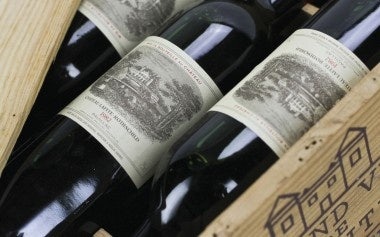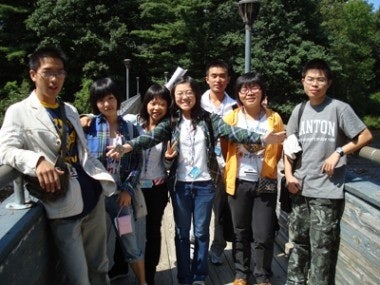A roundup of news coming out of China this week, from the Business of Fashion's list of top 20 media, business and cultural influencers to Lafite's new counterfeit-busting label and the booming business of outbound Chinese education.
The Top 20 Movers, Shakers and Decision-Makers in China Fashion (Business of Fashion)#

Today on the Business of Fashion, Hong Kong-based fashion journalist (and soon-to-be Jing Daily columnist) Divia Harilela profiles the top 20 "movers, shakers and decision-makers" in the China fashion world. Listing key players like supermodel Liu Wen, media figure and BNC proprietor Hong Huang, Adrienne Ma of Shouke/Outnet.cn, I.T.'s Sham Kar Wai and many more, the article is a must-read for anyone interested in who's who in the mainland China and Hong Kong fashion industries.
One of the most interesting aspects of the list is the sheer diversity of backgrounds, which over the past several years has become a defining factor of the Chinese fashion and luxury industries. As the article points out, these people include everything from "entrepreneurs, luxury executives, PR mavens, retail experts, editors, media moguls, models, [to] bloggers and others who each have tremendous expertise and insight in their chosen domain and, collectively, form the backbone of the country’s fast growing fashion ecosystem."
To Fight Counterfeiters, Chateau Lafite Rothschild Adopts Prooftag Security (Goedhuis & Co)#

One of the most popular wines among China's newly wealthy -- and among Chinese counterfeiters -- Chateau Lafite Rothschild has, perhaps moreso than any other high-end wine in the Chinese market, become synonymous with high prices and rampant knockoffs in recent years. Counterfeiting of Lafite has become so out-of-control that, as Simon Staples, buying director at Berry Bros & Rudd, pointed out, “At a recent trade fair in China, I saw merchants openly selling fake Lafite – as you would Louis Vuitton handbags in a market – in a small room next to the main tasting room."
With a growing number of wealthy Chinese wine collectors spooked by counterfeit Lafite and turning their back on the label, or diversifying into other wine regions like Burgundy, Chateau Lafite Rothschild has taken a high-tech effort to outdo knockoff artists. As Goedhuis & Co recently noted, both Chateau Lafite Rothschild and Carruades de Lafite labelled since Feb 2012 (Lafite 2009 + Lafite and Carruades 2010 onwards) will include the Prooftag security system. Using a dual-security label, Prooftag's Lafite system includes a seal applied to the bottle neck (at the back), partly on the capsule and partly on the glass.
The Prooftag seal provides two levels of protection, a one-of-a-kind bubble code that cannot be reproduced and a 13 character alphanumeric code specifically associated with the bubble code. To authenticate bottles of Lafite, potential buyers can visit the www.lafite.com website, enter the 13 digit code on the bottle, and then are are shown the bubble code to match against the bottle seal.
Resorting to more high-tech fraud prevention strategies, Lafite is following in the footsteps of other wine and spirits brands that have invested heavily in fighting counterfeits in the China market. With demand rising among China's wealthy drinkers and gift-givers, and counterfeits proliferating throughout the country, in recent years domestic Chinese baijiu makers Moutai and Wuliangye have introduced interesting security features. For its US$20,000 "Red Diamond" baijiu, Moutai created a unique serial numbers for each bottle of Red Diamond, and packaged them in special boxes with locking mechanisms that buyers could open only after calling a dedicated hotline to retrieve the password. Last year, Moutai rival Wuliangye followed suit, introducing a special RFID authentication website and in-store kiosks to give potential buyers peace of mind.
China's Ultra-Wealthy Big On Overseas Education (International Business Times)#

China's newly wealthy aren't only becoming interested in educating themselves about everything from wine to art, they're overwhelmingly focused on sending their children overseas to high-priced boarding schools. According to the Hurun Report and China Industrial Bank's Chinese Luxury Consumer White Paper 2012, nine out of every 10 Chinese with assets of more than 100 million yuan (US$16 million) plan to send their children abroad for study, while 85 percent of those with at least US$1 million said they plan to educate their children overseas. Due to intense competition and traditional values, education is big business in China and people are more than willing to spend on it. On average, Hurun noted, high-net-worth Chinese spend around 170,000 yuan (US$27,000) to educate each of their children. This makes education the third-highest expense for this demographic, after travel and luxury goods.
The popularity of overseas education among China's newly wealthy has seen the number of mainland Chinese students at American boarding schools and universities climb steadily in recent years. Since 2010, Chinese students have been the largest foreign contingent at US universities, with 157,588 arriving between 2010 and 2011. This marks a 23 percent increase over 2009-2010, and during the same period, the number of Chinese undergraduate students leapt 43 percent.
What all of this expenditure among Chinese and other foreign students in the US amounts to is a more than $20 billion boost to the US economy in the 2010-2011 academic year, when living and educational expenses are tallied up, according to Peggy Blumenthal, senior counselor to the president at the Institute of International Education. Added Blumenthal, China's one-child policy means many Chinese families see the education of their often only child as a good investment and consider American schools the international "gold standard." Though China's ultra-wealthy regularly raise more than one child, the country's middle class, which is more likely to have one child, has also shown a willingness to spend significant proportions of their income on overseas education.